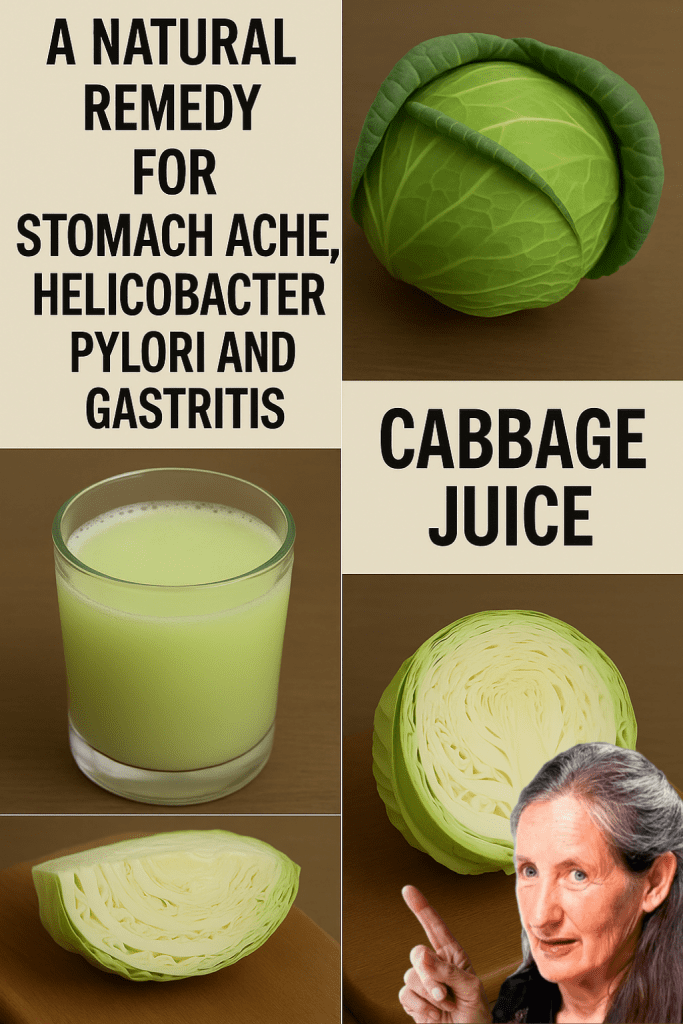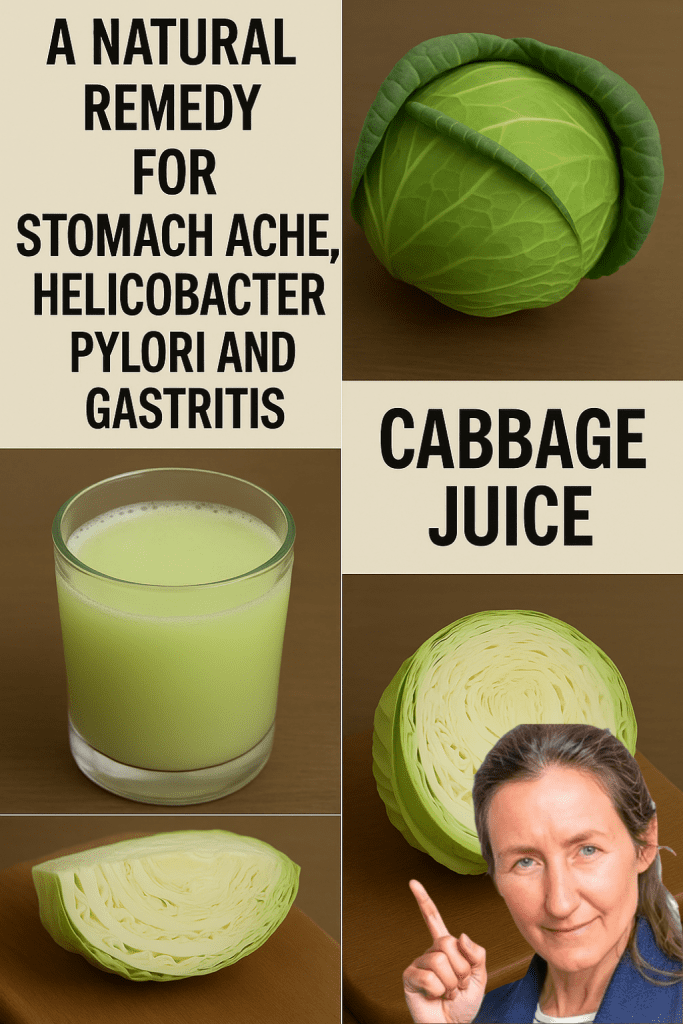Imagine a simple, natural remedy that could transform your digestive health, soothe nagging stomach pain, and even tackle harmful bacteria—all from an unassuming vegetable you probably have in your kitchen right now. What if we told you that cabbage juice, often overlooked, holds the key to unlocking a healthier gut and a happier you? This isn’t just another health trend; it’s a time-tested, nutrient-packed elixir that’s been quietly changing lives. Ready to discover why cabbage juice deserves a spot in your daily routine? Let’s dive into this vibrant, gut-healing journey and uncover the magic of this humble vegetable!

Why Cabbage Juice? The Gut-Healing Hero You Didn’t Know You Needed
Your stomach is the unsung hero of your body, tirelessly processing everything you eat and drink. But when it’s out of balance—whether from stress, poor diet, or pesky bacteria like H. pylori—it can leave you feeling miserable. Bloating, burning sensations, or even chronic discomfort can take over your life. That’s where cabbage juice swoops in like a natural superhero. Packed with vitamins, minerals, and unique compounds, this vibrant juice doesn’t just mask symptoms; it works at the root to heal, restore, and protect your digestive system.
What makes cabbage juice so special? It’s not just about the nutrients (though it’s loaded with vitamin C, K, folate, and antioxidants). It’s the synergy of its components—like glutamine, sulforaphane, and anti-inflammatory agents—that makes it a powerhouse for gut health. Whether you’re battling gastritis, ulcers, or just occasional tummy troubles, cabbage juice offers a gentle yet effective solution that’s been praised by natural health enthusiasts for decades. And the best part? It’s affordable, easy to make, and requires just one key ingredient: cabbage.
🌱 The Science Behind Cabbage Juice: Why It Works Wonders
Cabbage juice isn’t just folklore; it’s backed by science that highlights its remarkable benefits for your stomach and beyond. Let’s break down the key reasons why this green elixir is a game-changer for digestive health.
Soothes Inflammation and Heals Ulcers
One of the standout components of cabbage juice is glutamine, an amino acid that acts like a repair crew for your digestive tract. Glutamine nourishes the cells lining your stomach and intestines, helping to regenerate damaged tissue and reduce inflammation. For those suffering from gastritis or peptic ulcers, this can mean faster healing and lasting relief from pain. Studies have shown that glutamine-rich foods, like cabbage, can strengthen the mucosal lining of the stomach, creating a protective barrier against irritants.
Fights Off Harmful Bacteria
Helicobacter pylori (H. pylori) is a sneaky bacterium that’s often behind chronic stomach issues, including ulcers and gastritis. Left unchecked, it can wreak havoc on your gut. The good news? Cabbage juice contains unique compounds like sulforaphane, which have been shown to combat H. pylori naturally. Regular consumption of cabbage juice may help reduce the bacterial load in your stomach, giving your body a fighting chance to restore balance without relying solely on antibiotics.

Boosts Overall Nutrition
Cabbage is a nutritional powerhouse, and its juice concentrates those benefits into every sip. Rich in vitamin C, it supports your immune system, helping your body fend off infections. Vitamin K promotes healthy blood clotting and tissue repair, while folate aids in cell regeneration. The antioxidants in cabbage, including anthocyanins (especially in red cabbage), fight oxidative stress, which can contribute to chronic inflammation. Together, these nutrients create a holistic approach to healing, making cabbage juice a one-stop shop for gut and overall wellness.
Supports Detoxification
Your liver and digestive system work hand in hand to detoxify your body. Cabbage juice, with its high water content and natural enzymes, helps flush out toxins and supports healthy digestion. It’s like giving your insides a refreshing cleanse, leaving you feeling lighter and more energized.
🥬 How to Make Cabbage Juice: Your Step-by-Step Guide
Ready to harness the power of cabbage juice? Making it at home is simple, affordable, and requires minimal equipment. Whether you have a juicer or just a blender, you can whip up this gut-healing remedy in minutes. Here’s how to do it.
Ingredients
- 1 medium-sized fresh cabbage (green or red, both work wonders)
- Clean water (optional, for diluting or blending)
- Optional add-ins: apple, carrot, or celery for a flavor boost
Preparation
Start by selecting a fresh, vibrant cabbage—look for one that’s firm with crisp leaves. Rinse it thoroughly under running water to remove any dirt or pesticides. If possible, opt for organic cabbage to minimize chemical exposure. Peel off any wilted outer leaves, then chop the cabbage into smaller chunks. This makes it easier to juice or blend and ensures maximum extraction.
Juicing
If you have a juicer, you’re in luck—this is the easiest way to make cabbage juice. Simply feed the cabbage chunks through the juicer and collect the liquid gold in a glass. No juicer? No worries! A blender works just as well. Toss the cabbage pieces into the blender with a splash of water (start with ¼ cup and adjust as needed). Blend until smooth, then strain the mixture through a fine mesh sieve or cheesecloth to separate the juice from the pulp. Press down to squeeze out every last drop.
Serving
For the best results, drink your cabbage juice fresh—its nutrients are most potent right after juicing. The taste can be earthy and slightly bitter, especially with green cabbage, but don’t let that deter you. If it’s too strong, dilute it with a bit of water or mix in some apple or carrot juice for a sweeter, more palatable flavor. Red cabbage tends to be milder and slightly sweeter, making it a great choice for beginners. Serve chilled or at room temperature, depending on your preference.
Storage Tips
While fresh is best, you can store cabbage juice in an airtight container in the fridge for up to 24 hours. Shake well before drinking, as it may separate. Avoid storing it longer, as the nutrients begin to degrade over time.
🍹 Creative Ways to Enjoy Cabbage Juice
Not a fan of drinking cabbage juice straight? Get creative to make it more enjoyable while still reaping the benefits. Here are some ideas to elevate your cabbage juice experience.
- Green Goddess Smoothie: Blend cabbage juice with spinach, cucumber, green apple, and a squeeze of lemon for a refreshing, nutrient-packed smoothie.
- Spicy Gut Healer: Add a pinch of ginger or a dash of turmeric to your cabbage juice for an anti-inflammatory kick.
- Veggie Power Blend: Mix cabbage juice with carrot, beet, and celery juice for a vibrant, detoxifying drink that’s as beautiful as it is healthy.
- Morning Tonic: Start your day with a shot of cabbage juice mixed with warm water and a touch of honey for a gentle wake-up call for your digestive system.
Experiment with ratios and flavors until you find a combination that excites your taste buds. The goal is to make cabbage juice a regular part of your routine without feeling like a chore.
💊 Dosage: How Much Cabbage Juice Should You Drink?
If you’re new to cabbage juice, start slow to let your body adjust. Begin with a small amount—about ½ cup (4 ounces)—once a day, preferably on an empty stomach for optimal absorption. After a few days, you can gradually increase to 1 cup (8 ounces) daily. Drinking it first thing in the morning or 30 minutes before a meal works best, as it allows the nutrients to get to work without interference from other foods.
For those dealing with specific issues like gastritis or ulcers, some natural health practitioners recommend up to 2 cups daily, split into smaller servings (e.g., ½ cup four times a day). However, always listen to your body. If you experience any discomfort, such as bloating or gas, reduce the amount and build up more slowly.
⚠️ Precautions and When to Seek Medical Advice
Cabbage juice is generally safe for most people, but it’s not a one-size-fits-all solution. If you have a thyroid condition, consult your doctor before adding large amounts of cabbage juice to your diet, as cruciferous vegetables can affect thyroid function in some cases. Additionally, if you’re on blood-thinning medications, be mindful of cabbage’s high vitamin K content, which can influence clotting.
While cabbage juice is a powerful ally for mild to moderate digestive issues, it’s not a replacement for professional medical care. Persistent or severe symptoms—such as intense abdominal pain, blood in your stool, or unexplained weight loss—require immediate attention from a healthcare provider. Use cabbage juice as a complementary tool, not a cure-all.
🌟 Why Cabbage Juice Deserves a Spot in Your Wellness Routine
In a world filled with expensive supplements and complicated diets, cabbage juice stands out as a refreshingly simple, budget-friendly remedy that delivers real results. It’s more than just a drink—it’s a commitment to nurturing your body from the inside out. By soothing inflammation, fighting harmful bacteria, and flooding your system with essential nutrients, cabbage juice empowers you to take control of your digestive health naturally.
Picture this: a daily glass of vibrant, nutrient-rich juice that not only calms your stomach but also boosts your energy, strengthens your immunity, and leaves you feeling revitalized. That’s the magic of cabbage juice. Whether you’re sipping it straight, blending it into a smoothie, or experimenting with new flavors, you’re giving your body a gift that keeps on giving.
So, why wait? Grab a head of cabbage, fire up your juicer or blender, and embark on a gut-healing adventure that’s as rewarding as it is delicious. Your stomach will thank you, and you’ll wonder why you didn’t discover this hidden gem sooner. Here’s to vibrant health, one sip at a time!









